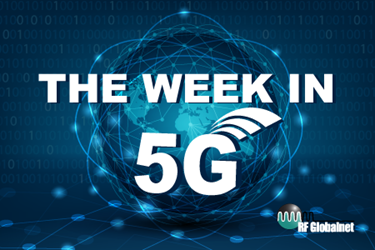The Week in 5G — Huawei Looks to Skirt U.S. Ban, Researchers Eye 5G For Charging & Imaging Applications

By Abby Proch, former editor

Over the past few weeks, the realm of 5G has been abuzz with the FAA’s last-minute demand to delay 5G for fear its use will interfere with aircraft navigation systems. Telecoms acquiesced and their rollouts have been pushed back until Jan. 5, 2022. But since the FAA’s plea, critics (including the FCC) have questioned two things: whether interference really will occur (given the two operations will be separated by more than 200 MHz of spectrum) and why the FAA didn’t speak up sooner. While some critics have claimed the latter is just a result of governmental infighting, the former issue might be addressed by real world examples. According to the CTIA, which represents the U.S. wireless communications industry, 17 years of research and 40 countries currently operating with no interference from 5G prove the two can coexist without any further accommodations. It’s not yet known whether a compromise — or even another delay — is on the horizon.
On top of near-universal enthusiasm to rollout 5G, GSMA, an industry organization representing mobile operators worldwide, is founding an accelerator initiative to champion the use of mmWave frequencies to realize 5G’s full potential. According to a report by Computer Weekly, GSMA claims that 5G mmWave, which inhabits spectrum above 24 GHz, would bolster 5G rollouts with greater capacity, allowing multi-gigabit wireless speeds and low latency, and enable expansion to Fixed Wireless Access (FWA). What’s more, the use of mmWave would also save up to 35% in cost of ownership compared with the sole use of sub-6 GHz bands, says GSMA.
5G for telecommunications is the application of note, but researchers are also considering alternative uses. Can 5G radio waves produce images the way radar does? That’s the question researchers at Binghamton University will try to answer after securing a roughly $300,000 grant from the U.S. Air Force. According to a report by Engineering360, associate professors Yu Chen and Xiaohua Li will use mmWave cameras and 5G-based sensing technologies in hopes of achieving something similar, if not better, than an infrared camera. The difference, they hope, is that their system will not only endure all weather conditions but also yield a shorter delay than radar and be more reliable than radar due to base station and antenna density. If feasible, the method offers many military applications, including identifying combatants at the tactical edge in cramped, complex urban areas.
Another interesting application has cropped up in Japan: the potential for 5G to provide power. SoftBank, a Japanese tech company, announced that it’s beginning trials in which smartwatches and earbuds are charged through 5G antennas, according to Bleeping Computer. The idea is that once a person wearing a device approaches a 5G station — about 10 meters, but potentially up to 100 meters — the device will begin charging. Every iteration of on- or near-body RF technology comes with some degree of concern for safety, but SoftBank is assuring skeptics that the wearable will only receive about 1 milliwatt of power. The first tests will occur indoors, with the potential for outdoor use licenses in 2024.
Despite what was likely a mix between a burst of cheer and a sigh of relief from the telecommunications industry after the passing of the Infrastructure Investment and Jobs Act, which aims to provide $65 billion for broadband access, some say the investment overlooks the dire need for wireless connectivity. In a white paper, the Competitive Carriers Association contends that $36 billion — more than the existing $9 million available in the Universal Service Fund — is needed to truly close the digital divide by providing 5G coverage for all Americans, especially those in rural areas. As a start, CCA is asking that $11 billion from the FCC’s Rural Digital Opportunity Fund Phase II, which was allotted for broadband, should be redirected for 5G infrastructure since the IIJA has already allotted plenty toward broadband.
In what seems to be an attempt to sidestep U.S. sanctions, Huawei is contemplating licensing its cell phone designs to third parties in order to recoup some of their faltering smartphone business. According to Bloomberg, confidential sources close to the conversation say Huawei might skirt the ban with Xnova, a part of state-owned China Postal and Telecommunications Appliances Co. (PTAC). Xnova currently sells Huawei phones, but the new endeavor will also allow it to sell Huawei designs under its own branding. The report also claims that Huawei engineers are already redesigning some smartphone circuits to align with Qualcomm and MediaTek Inc. processors, which Huawei currently can’t access under its own name.
In other Huawei news, the tech giant and Zhejiang Mobile paired up recently to complete early verification of Huawei’s 5G next-gen massive MIMO. According to GizChina, the pair recorded a 5dB increase in uplink and downlink coverage as well as an edge rate increase between 30% and 40% compared with active antenna units. The approach combines hardware and software advances, namely a large-scale antenna array and an intelligent algorithm that yields narrower service channel beams, according to the report.
Finally, in mergers and acquisitions, American Tower is acquiring CoreSite for $10.1 billion to become a 5G global leader that puts wireless connectivity at the mobile edge and interconnected data centers at the core edge. In the deal, American Tower, known as an owner, operator and developer of communications real estate, will acquire all of CoreSite’s 25 data towers, 21 cloud on-ramps, and more than 32,000 interconnections across the U.S., according to CRN.
